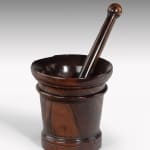Turned Lignum Vitae Mortar and Pestle
ENGLAND, CIRCA 1750
13 x 12.1 x 21 cm
5 ¼ x 4 ¾ x 8 ¼ in
5 ¼ x 4 ¾ x 8 ¼ in
6859
Of tapered form, with turned ring decoration beneath the rim and to the foot. Such small mortars were used in domestic settings or in the apothecary. In ‘Treen for the...
Of tapered form, with turned ring decoration beneath the rim and to the foot.
Such small mortars were used in domestic settings or in the apothecary. In ‘Treen for the Table - Wooden Objects Related to Eating and Drinking’, (Antique Collectors’ Club 1998), Jonathan Levi says ‘Lignum vitae, because of its hardness and dense grain, became the wood of choice for mortars when importation started in the late sixteenth and early seventeenth centuries.' , p. 110).
According to Edward H. Pinto when used in an apothecary lignum vitae’s ‘imaginary medicinal qualities were supposed to benefit the mixture compounded.’ (Treen and Other Wooden Bygones’, Bell & Hyman Limited, London, 1979 p.182).




